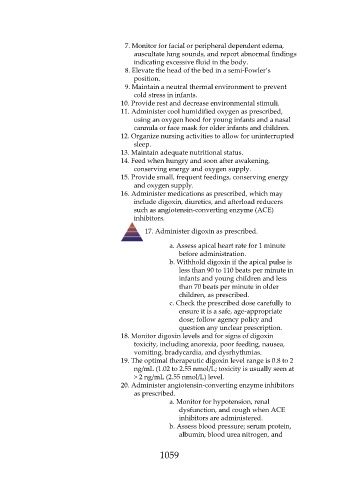Page 1059 - Saunders Comprehensive Review For NCLEX-RN
P. 1059
7. Monitor for facial or peripheral dependent edema,
auscultate lung sounds, and report abnormal findings
indicating excessive fluid in the body.
8. Elevate the head of the bed in a semi-Fowler’s
position.
9. Maintain a neutral thermal environment to prevent
cold stress in infants.
10. Provide rest and decrease environmental stimuli.
11. Administer cool humidified oxygen as prescribed,
using an oxygen hood for young infants and a nasal
cannula or face mask for older infants and children.
12. Organize nursing activities to allow for uninterrupted
sleep.
13. Maintain adequate nutritional status.
14. Feed when hungry and soon after awakening,
conserving energy and oxygen supply.
15. Provide small, frequent feedings, conserving energy
and oxygen supply.
16. Administer medications as prescribed, which may
include digoxin, diuretics, and afterload reducers
such as angiotensin-converting enzyme (ACE)
inhibitors.
17. Administer digoxin as prescribed.
a. Assess apical heart rate for 1 minute
before administration.
b. Withhold digoxin if the apical pulse is
less than 90 to 110 beats per minute in
infants and young children and less
than 70 beats per minute in older
children, as prescribed.
c. Check the prescribed dose carefully to
ensure it is a safe, age-appropriate
dose; follow agency policy and
question any unclear prescription.
18. Monitor digoxin levels and for signs of digoxin
toxicity, including anorexia, poor feeding, nausea,
vomiting, bradycardia, and dysrhythmias.
19. The optimal therapeutic digoxin level range is 0.8 to 2
ng/mL (1.02 to 2.55 nmol/L; toxicity is usually seen at
> 2 ng/mL (2.55 nmol/L) level.
20. Administer angiotensin-converting enzyme inhibitors
as prescribed.
a. Monitor for hypotension, renal
dysfunction, and cough when ACE
inhibitors are administered.
b. Assess blood pressure; serum protein,
albumin, blood urea nitrogen, and
1059

